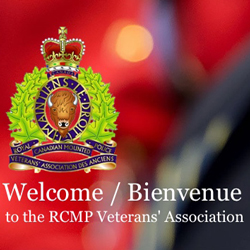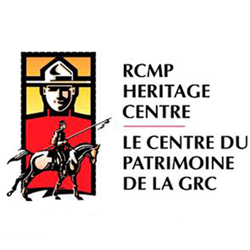Ric Hall: The Barker Family’s Force History
Recently I did an article for the Vancouver Veterans’ web site in response to a query from retired Staff Sergeant Doug Buchta regarding the changes to the wearing of Sam Browne equipment by Officers and Sergeants Major.
His question was as a result of seeing pictures of the trophy presentation after the final game between Canada and Russia in the IIHF tournament in which a Staff Sergeant Major and Constable were carrying the winner’s trophy.
Soon after the article hit the air waves, I received an e-mail message from Doug. We e-chatted about the changes in the wearing of the Sam Browne as a result of the recent events in Ottawa.
He then threw in that I had been his Drill Instructor when he went through training as a member of Troop #19 74/75. He also added that he had a photograph of his wife’s grandfather, Francis “Frank” Barker, a RNWMP member, carrying the coffin of Sam Steele. Enough talk about Sam Brownes, could he share that photograph with me and in turn could I share the picture with the Vancouver Veterans’ Association? Doug and his wife Joan were kind of to send me a copy of the photograph and many more which show a bigger family connection to the Force.
Francis (Frank) Walter John Barker, Regimental # 6397, was born February 11th, 1893, Essex, England. He immigrated to Canada as a 22 year old wanting to become a cowboy. He and his older brother, Arthur, did just that, becoming, among many other things, members of the RNWMP posted as ‘Rough Riders’ at “Depot” Division.
He was an accomplished soccer player with a very quiet and pleasant demeanor, a gentleman others readily gravitated toward. Frank served with the Mounted Police from March 5th, 1915 until his retirement on February 28th 1946 as a Staff Sergeant, his time in the Force included service overseas as a member of the RNWMP Cavalry Draft with “A” Squadron, the first contingent of 726 men, all of whom were RNWMP. Frank saw action in World War I in both France and Belgium, safely returning to Canada in 1919 to continue his policing career with the RNWMP/RCMP.

Photograph of Frank Barker as a member of the Force (Source of photo – Ric Hall’s Photo Collection).

Photograph of RCMP Corporal Frank Barker being photographs with a first nations member (Source of photo – Ric Hall’s Photo Collection).

Photograph of RCMP Staff Sergeant Frank Barker (Reg.#6397) prior to retirement. (Source of photo – Ric Hall’s Photo Collection).
Upon retiring from the Force, Frank served as Wynyard, Saskatchewan’s Chief of Police for the following 10 years, then worked as a member of the Corps of Commissionaires in Calgary, AB, until his passing in 1972. He dedicated 42 years of his life to public service, proudly serving his adopted country. He was truly a very special man.
Frank Barker was involved in a very significant moment in the history of Canada and the Force. He was selected as one of eight pall bearers for Sam Steele’s funeral in Winnipeg, Manitoba, July 3rd 1919 (Sam Steele died just after his 70th birthday in England, one of the many victims of the influenza epidemic of 1918). Joan Buchta’s grandmother, Minnie Barker, actually wrote on the back of a photo, in which Frank and his colleagues are carrying the remains of Major General Sir Sam Steele, KCMG, CB, MVO.
Although the actual month on this photograph has since been obliterated, she recorded the date as _____ the 25th, 1919. The funeral at St. John’s Cemetery in Winnipeg, Manitoba did take place on July 3rd, 1919. The discrepancy cannot be explained. She also recorded the names of six of the eight pall bearers, Sgts. Thawaite & Mann, Cpls Colfer & Barker, and Csts. Campbell and Johnson. She may not have known the names of the other two members. Frank W. J. Barker, is on the left rear of Sam Steele’s coffin, just in front of the Minister.

Photograph of Royal North West Mounted Police members carrying the casket of Major General Sam Steele. (Source of photo – Ric Hall’s Photo Collection).
How many cadets in training have marched towards the RCMP Cemetery at “Depot” Division and not realized the significance the name of the street has…Barker Ave.

Photograph of the “Depot” Division’s street sign named in the honour of Sergeant Arthur Barker (Source of photo – Ric Hall’s Photo Collection).

Photograph of a “Depot” Silent Partner card given to cadets in training. This card is in the name of Sergeant Arthur Barker (Source of photo – Ric Hall’s Photo Collection).
Perhaps, those few cadets who receive the “Silent Partner” card for Sergeant Arthur Barker, Reg # 7606, do. But do they realize the connection to other members of the Force?

Photograph of RCMP Sergeant Arthur Barker (Reg.#7606) and #64 on the RCMP’s Honor Roll (Source of photo – Ric Hall’s Photo Collection).
Sergeant Arthur Barker is the older brother of Staff Sergeant Frank Barker. Sergeant Arthur Barker is #64 on the RCMP Honour Roll. Arthur Barker joined the RNWMP in April 1919. It is unclear whether Anthony left the RNWMP, or prior to joining the Force, he joined the US Calvary and while overseas he discharged only to mount up with the British Calvary for the duration of WW I. The family has an old newspaper clipping alluding to his Cavalry experience.

Photograph Corporal Arthur Barker breaking a horse at RNWMP “Depot” in Regina (Source of photo – Ric Hall’s Photo Collection).
Upon his return to Canada he joined the RNWMP and then left the Force to join the Saskatchewan Provincial Police and then returned to the Force when the latter was absorbed into the RCMP. He continued his service in Saskatchewan. A former associate of Arthur Barker’s, retired Sergeant Gardner Greenlay (Reg # 3805), had a troubled son, Victor. Barker befriended Victor, who called him March 16, 1940, from a hotel at Shaunavon, SK. Barker went there to see Victor, and after a brief visit, left Victor’s room. He was downstairs in the hotel lobby, pulling on his overshoes, when Victor suddenly appeared with a revolver and shot him three times.

Photograph of three handsome RCMP members. Corporal Arthur Barker is standing in the rear. (Source of photo – Ric Hall’s Photo Collection).
Shortly after the murder, it became clear that Greenlay was insane, suffering from schizophrenia. Victor Van Allen, another rancher in the south country, testified at the coroner’s inquest on March 18th that he took Greenlay to Shaunavon that Saturday afternoon. On the way into town, some of the things Greenlay said made Van Allen realize he was not “normal.” Greenlay told Van Allen that was going to Shaunavon to see Sergeant Barker because together they would be able to prevent the Canadian government from selling horses to France. Greenlay said he feared trouble was to break out, and that “within a week there will be troops in the saddle,” adding that “Christ will appear in Germany in the form of a woman, and will turn the forces against Germany.”

Photograph of RCMP Corporal Arthur Barker on horseback (Source of photo – Ric Hall’s Photo Collection).
When they arrived in town, Greenlay phoned Sergeant Barker at about 7 o’clock and asked him to come to his room at the Grand Hotel. Barker, his wife, Gladys and their son Kenneth walked downtown, and while his family went to the library, Barker visited with Greenlay in his hotel room. According to his later testimony, during their visit Greenlay apparently asked the RCMP officer to intervene for him with a girlfriend, and Barker demurred. When Barker left Greenlay’s room around 9:00 PM, Greenlay said he “heard a voice tell me to go out and shoot the evil beast.” He headed down the hotel stairs where he saw that Barker was not a man, but “a devil,” and he pulled the trigger of his .38 revolver three times, Victor Greenlay was tried for murder, found criminally insane, and was committed to a mental hospital.

Photograph of the RCMP Cenotaph at “Depot” Division. Sergeant Arthur Barker’s name is circled in red in this photograph (Source of photo – Ric Hall’s Photo Collection).
Bernard “Bernie” Ormond Barker, Reg # 13963, was born in Carievale, SK, in 1921. The son of Frank Barker, Reg # 6397, and the nephew of Arthur Barker, Reg # 7606.
He joined the RCMP in January 1941, just a few months after his uncle was shot and killed March 1940, at Shaunavon.
After training Bernie’s first posting was to the Intelligence Branch, Toronto and then he was with the Central Registry in “A” Division. From January 1, 1942 to October 13, 1945 he served with the RCMP Provost Corps.

Photograph of Bernie Barker – Radio Operator No.1 Provost Corps (RCMP) – World War II (Source of photo – Ric Hall’s Photo Collection).
He went overseas as a member of the No 1 Provost Corps (RCMP) in WWII, almost identical to that of his father before him, just different World Wars. He served in France and Italy.

Extreme right – B.O. Barker in equitation training after World War II (Source of photo – Ric Hall’s Photo Collection).
Bernie returned to Canada in 1945, going directly to Ottawa to take the required Equestrian training which he had not taken, before eventually embarking on his policing career. He served at Saskatoon and Kindersley. In 1946 he returned to “O” Division working at Toronto Town Station, two years later moving onto Kirkland Lake. In 1955 he moved to “K’ Division.

Canadian Post card containing the image of RCMP Corporal Bernie Barked. Card outlines he is from “Eskimoland” Canada. – how politically incorrect today! (Source of photo – Ric Hall’s Photo Collection).
Later in his career, 1962, he was NCO i/c Peace River Detachment and 1965 he was promoted to Staff Sergeant, the NCO i/c of Grande Prairie Detachment, he was coaxed into retiring by Inspector Marcus, Reg # 14393/O.533, O.C. Peace River Sub-Division, in order to become one of the last three lay Part XVI Magistrates in Alberta.
Too many of us who testified in court before Barker he was known as “B.O. Barker”, his initials, as we added his name to traffic tickets and informations for swearing. As a young Highway Patrol member in Peace River, one dark night I clocked a car through radar, we allowed a minimum of 15 mph over the posted speed limit due to the lack of traffic and wide, long straight stretches of highway. I chased the car down and informed the driver that he had been clocked at such and such speed, while he handed over his driver’s license. Mmmh…. Bernard Ormond Barker, it has a bit of a ring. B.O. Barker! At the same time as this was sinking in he was strongly indicating to me that he “had not been speeding!” Knowing full well that I would probably have to appear before him in a trial sometime down the road, police officer discretion was used and he was told that he was only in the “warning” area. “Have a good night Sir!” Little did I know in those early days of B.O. Barker’s service to Canada during WW II.
Later Bernie Barker was appointed a full fledged Judge. He did very well for a ‘lay’ person, and completed several cycles as President of the Alberta Judges Association. He passed suddenly in the prime of his life at an early age of 64. He had purchased a motorcycle late in the fall of that preceding year, as he was planning a long motorcycle trip into the Arizona desert with his son-in-law, Doug Buchta. He never even got to ride his motorcycle, let alone take a trip with it.

Photograph of RCMP S/Sgt. Bernard “Bernie” Ormond Barker – Reg.#13963 (Source of photo – Ric Hall’s Photo Collection).

Photograph of three RCMP members in red serge. Corpoal Bernie Parker is in the centre. (Source of photo – Ric Hall’s Photo Collection).
We all have stories to tell, sometimes embellished, of our time at “Depot.” When Doug and I connected he had to relate one of his memories of training and the Drill Hall. Just to leave this story with a smile on your face, this may trigger some of your own memories of training. Remember….what happens in the Drill Hall stays in the Drill Hall!

1974/75 – Photograph of RCMP “Depot” Division Drill Hall (Source of photo – Ric Hall’s Photo Collection).
“As a recruit in training, it was immediately apparent to me that time management skills were an ever important attribute, an attribute that would serve well while trying to ‘survive’ the rigors of 6 months of RCMP Training in “Depot.” Training during the cold winter months meant all our drill classes were held inside the Drill Hall. As such, we were all required to hang our Pea Jackets in the front cloak room, an area akin to a sardine can, with 32 burley ‘sardines’ all trying to get undressed/dressed at the same time! Our drill instructor was none other than Cpl. Ric Hall. At the end of every class, Cpl. Hall would dismiss the troop, sending each member scurrying toward his Pea Jacket, each wanting to get dressed and formed up outside as quickly as possible. As was the tradition, the last one to ‘form up’ had to drop to the cold pavement and do the prescribed number of push-ups. Sadly, every time we stampeded through that cloakroom, our spit polished boots took a beating, necessitating several hours of extra work each & every evening. I called a troop meeting one cold winter night, suggesting we could solve the scuffed shoe polish problems by simply picking one troop mate to linger upon being dismissed, with the others working their way through the cloakroom in an orderly manner without risk of damaging their spit and polish. The designated member would ensure he was last to form up, thereby doing his comeuppance on behalf of the entire troop. Each would take his turn as the designated malingerer, with me even volunteering to be the first; after all, it was my idea. Problem solved, right?
Well, not quite, as things turned out. Upon being dismissed from our very next drill class Cpl. Hall watched with obvious curiosity as all 31 of us (we were one member short of 32) slowly, and without incident, dressed and formed up. I delayed just long enough to be last and as I stood there in troop formation in front of the Drill Hall, I waited for Cpl. Hall’s punishment. To my total dismay, Cpl. Hall asked who’s idea this was and, being a good Mountie, I immediately proved. A millisecond later Cpl. Hall had all 30 troop members down on the pavement doing an inordinate number of push-ups while I stood there at attention watching! Needless to say that was the end of that ‘time management’ strategy. I have often wondered how many cans of black shoe polish the “Depot” Canteen actually sold? Those were the days, to be sure.” Buchta – Troop 1974/75.

Photograph of S/Sgt. (Ret’d) Douglas Buchta – Reg.#31903 – son-in-law of Bernie Barker. (Source of photo – Ric Hall’s Photo Collection).
A very special thank you to Doug and Joan Buchta for sharing their photographs and stories of Joan’s father, Bernie Barker, grandfather, Frank Barker, and his brother, Arthur Barker.
If you have a similar family history, please consider contacting Ric at rshall69@telus.net.


 January 29, 2015
January 29, 2015 













